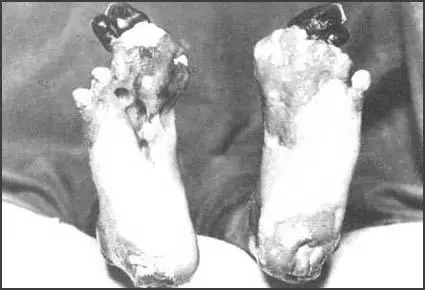Trench Foot
Many soldiers fighting in the First World War suffered from trench foot. This was an infection of the feet caused by cold, wet and insanitary conditions. In the trenches men stood for hours on end in waterlogged trenches without being able to remove wet socks or boots. The feet would gradually go numb and the skin would turn red or blue. If untreated, trench foot could turn gangrenous and result in amputation. Trench foot was a particular problem in the early stages of the war. For example, during the winter of 1914-15 over 20,000 men in the British Army were treated for trench foot. Brigadier-General Frank Percy Crozier argued that: " The fight against the condition known as trench-feet had been incessant and an uphill game."

Arthur Savage pointed out that trench foot had serious consequences: "My memories are of sheer terror and the horror of seeing men sobbing because they had trench foot that had turned gangrenous. They knew they were going to lose a leg." Brigadier-General Frank Percy Crozier explained how the officers tried to solve the problem: "Socks are changed and dried in the line, thigh boots are worn and are dried every four days when we come out."
The only remedy for trench foot was for the soldiers to dry their feet and change their socks several times a day. By the end of 1915 British soldiers in the trenches had to have three pairs of socks with them and were under orders to change their socks at least twice a day. As well as drying their feet, soldiers were told to cover their feet with a grease made from whale-oil. It has been estimated that a battalion at the front would use ten gallons of whale-oil every day.
Primary Sources
(1) After the war, Captain G. H. Impey, 7th Battalion, Royal Sussex Regiment, wrote about his experiences of trench life.
The trenches were wet and cold and at this time some of them did not have duckboards and dug-outs. The battalion lived in mud and water. Altogether about 200 men were evacuated for trench feet and rheumatism. Gum boots were provided for the troops in the most exposed positions. Trench feet was still a new ailment and the provision of dry socks was vitally important. Part of the trench was reserved for men to go two at a time, at least once a day, and rub each other's feet with grease.
(2) Sergeant Harry Roberts, Lancashire Fusiliers, interviewed after the war.
If you have never had trench feet described to you. I will tell you. Your feet swell to two or three times their normal size and go completely dead. You could stick a bayonet into them and not feel a thing. If you are fortunate enough not to lose your feet and the swelling begins to go down. It is then that the intolerable, indescribable agony begins. I have heard men cry and even scream with the pain and many had to have their feet and legs amputated.
(3) At the age of 92, Arthur Savage was asked about his memories of life on the Western Front.
My memories are of sheer terror and the horror of seeing men sobbing because they had trench foot that had turned gangrenous. They knew they were going to lose a leg. Memories of lice in your clothing driving you crazy. Filth and lack of privacy. Of huge rats that showed no fear of you as they stole your food rations. And cold deep wet mud everywhere. And of course, corpses. I'd never seen a dead body before I went to war. But in the trenches the dead are lying all around you. You could be talking to the fellow next to you when suddenly he'd be hit by a sniper and fall dead beside you. And there he's stay for days.
(4) Robert Sherriff, No Leading Lady (1968)
Some of their feet were horrible to look at: raw skin and bleeding blisters and big, angry sores. Their army boots rarely fitted comfortably. They were made in a few standard sizes, and a man was lucky if he got a pair that was neither too big nor too small. To march all day in them with blistered feet must have been a torment... The men marched like beasts of burden with heavy packs on their backs, rifles and bandoliers of ammunition slung across their shoulders. Sometimes they would break into a marching song to ease the misery, but now and then, as I marched at the head of my platoon, I would hear a clatter behind me and turn to see a man lying prostrate in the road.
The sergeants were instructed to prod them and order them to get up. There was always the possibility that the man had decided that he had taken as much as he could bear and had staged his collapse to get out of it. But most of them were genuine - down and out.
(5) Frank Percy Crozier, A Brass Hat in No Man's Land (1930)
The fight against the condition known as "trench-feet" had been incessant and an uphill game. However, science and discipline had conquered, and now we seldom have a case, and if we do there is trouble. Socks are changed and dried in the line, thigh boots are worn and are dried every four days when we come out. Things are better, but the weather gets worse.
